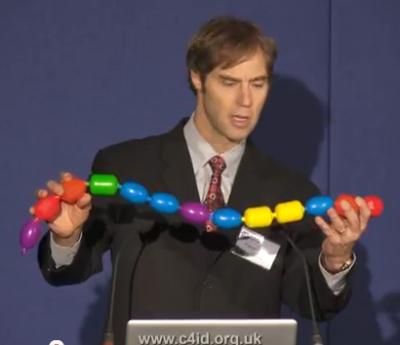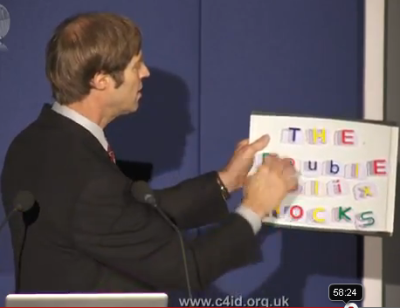Today, I decided to go back in time, and re-post something from April 2009. I started this blog in January 2009. It’s funny to see what I sounded like when I was just starting out. Dr. Craig has a short video about this argument, and Rose and I did a podcast about it, where we focused on the scientific evidence for cosmic fine-tuning. This is a simple argument. I wish Christian leaders taught it in church.
First of all, if you’re not clear on the fine-tuning argument, click here and read Walter Bradley’s exposition of it. Dr. Walter L. Bradley (C.V. here) is the Distinguished Professor of Engineering at Baylor University. He was also a professor and department head at Texas A&M before going to Baylor. He had his Ph.D at age 24 from the University of Texas and was a tenured professor at 27.
The first argument presented by Bradley in that post is the same argument that Craig used against Hitchens in their debate. (It’s Craig’s second argument in the set of five). Bradley’s version of the argument has been presented live, in-person by Bradley at dozens of universities here and abroad, in front of students and faculty.
The fine-tuning argument
The argument goes like this:
- The fine-tuning of the universe to support life is either due to law, chance or design
- It is not due to law or chance
- Therefore, the fine-tuning is due to design
What does it meaning to be fine-tuned for life?
Here are the facts on the fine-tuning:
- Life has certain minimal requirements; long-term stable source of energy, a large number of different chemical elements, an element that can serve as a hub for joining together other elements into compounds, etc.
- In order to meet these minimal requirements, the physical constants, (such as the gravitational constant), and the ratios between physical constants, need to be withing a narrow range of values in order to support the minimal requirements for life of any kind.
- Slight changes to any of the physical constants, or to the rations between the constants, will result in a universe inhospitable to life.
- The range of possible ranges over 70 orders of magnitude.
- The constants are selected by whoever creates the universe. They are not determined by physical laws. And the extreme probabilities involved required put the fine-tuning beyond the reach of chance.
- Although each individual selection of constants and ratios is as unlikely as any other selection, the vast majority of these possibilities do not support the minimal requirements of life of any kind. (In the same way as any hand of 5 cards that is dealt is as likely as any other, but you are overwhelmingly likely NOT to get a royal flush. In our case, a royal flush is a life-permitting universe).
Examples of finely-tuned constants
Here are a couple of examples of the fine-tuning. Craig only gave one example in the debate and didn’t explain how changes to the constant would affect the minimal requirements for life. But Bradley does explain it, and he is a professional research scientist, so he is speaking about things he worked in his polymer research lab. (He was the director)
a) The strong force: (the force that binds nucleons (= protons and neutrons) together in nucleus, by means of meson exchange)
- if the strong force constant were 2% stronger, there would be no stable hydrogen, no long-lived stars, no hydrogen containing compounds. This is because the single proton in hydrogen would want to stick to something else so badly that there would be no hydrogen left!
- if the strong force constant were 5% weaker, there would be no stable stars, few (if any) elements besides hydrogen. This is because you would be able to build up the nuclei of the heavier elements, which contain more than 1 proton.
- So, whether you adjust the strong force up or down, you lose stars than can serve as long-term sources of stable energy, or you lose chemical diversity, which is necessary to make beings that can perform the minimal requirements of living beings. (see below)
b) The conversion of beryllium to carbon, and carbon to oxygen
- Life requires carbon in order to serve as the hub for complex molecules, but it also requires oxygen in order to create water.
- Carbon is like the hub wheel in a tinker toy set: you can bind other elements together to more complicated molecules (e.g. – “carbon-based life), but the bonds are not so tight that they can’t be broken down again later to make something else.
- The carbon resonance level is determined by two constants: the strong force and electromagnetic force.
- If you mess with these forces even slightly, you either lose the carbon or the oxygen.
Either way, you’ve got no life of any conceivable kind.
Is the fine-tuning real?
Yes, it’s real and it is conceded by the top-rank of atheist physicists. Let me give you a citation from the best one of all, Martin Rees. Martin Rees is an atheist and a qualified astronomer. He wrote a book called “Just Six Numbers: The Deep Forces That Shape The Universe”, (Basic Books: 2001). In it, he discusses 6 numbers that need to be fine-tuned in order to have a life-permitting universe.
Rees writes here:
These six numbers constitute a ‘recipe’ for a universe. Moreover, the outcome is sensitive to their values: if any one of them were to be ‘untuned’, there would be no stars and no life. Is this tuning just a brute fact, a coincidence? Or is it the providence of a benign Creator?
There are some atheists who deny the fine-tuning, but these atheists are in firm opposition to the progress of science. The more science has progressed, the more constants, ratios and quantities we have discovered that need to be fine-tuned. Science is going in a theistic direction. Next, let’s see how atheists try to account for the fine-tuning, on atheism.
Atheistic responses to the fine-tuning argument
There are two common responses among atheists to this argument.
The first is to speculate that there are actually an infinite number of other universes that are not fine-tuned, (i.e. – the gambler’s fallacy). All these other universes don’t support life. We just happen to be in the one universe is fine-tuned for life. The problem is that there is no way of directly observing these other universes and no independent evidence that they exist.
Here is an excerpt from an article in Discover magazine, (which is hostile to theism and Christianity).
Short of invoking a benevolent creator, many physicists see only one possible explanation: Our universe may be but one of perhaps infinitely many universes in an inconceivably vast multiverse. Most of those universes are barren, but some, like ours, have conditions suitable for life.
The idea is controversial. Critics say it doesn’t even qualify as a scientific theory because the existence of other universes cannot be proved or disproved. Advocates argue that, like it or not, the multiverse may well be the only viable nonreligious explanation for what is often called the “fine-tuning problem”—the baffling observation that the laws of the universe seem custom-tailored to favor the emergence of life.
The second response by atheists is that the human observers that exist today, 14 billion years after the universe was created out of nothing, actually caused the fine-tuning. This solution would mean that although humans did not exist at the time the of the big bang, they are going to be able to reach back in time at some point in the future and manually fine-tune the universe.
Here is an excerpt from and article in the New Scientist, (which is hostile to theism and Christianity).
…maybe we should approach cosmic fine-tuning not as a problem but as a clue. Perhaps it is evidence that we somehow endow the universe with certain features by the mere act of observation… observers are creating the universe and its entire history right now. If we in some sense create the universe, it is not surprising that the universe is well suited to us.
So, there are two choices for atheists. Either an infinite number of unobservable universes that are not fine-tuned, or humans go back in time at some future point and fine-tune the beginning of the universe, billions of years in the past.
Why the fine-tuning argument matters
We need to make a decision today about how we are going to live. The evidence available today supports the fine-tuning of the universe by a supernatural mind with immense power. The progress of science has strengthened this theory against determined opposition from rival naturalistic theories.
Those are the facts, and we must all choose what to do with them.
Further study
Here is a paper by Walter L. Bradley that contains many more examples of the fine-tuning, and explanations for what happens when you change the constants, quantities and rations even slightly.




